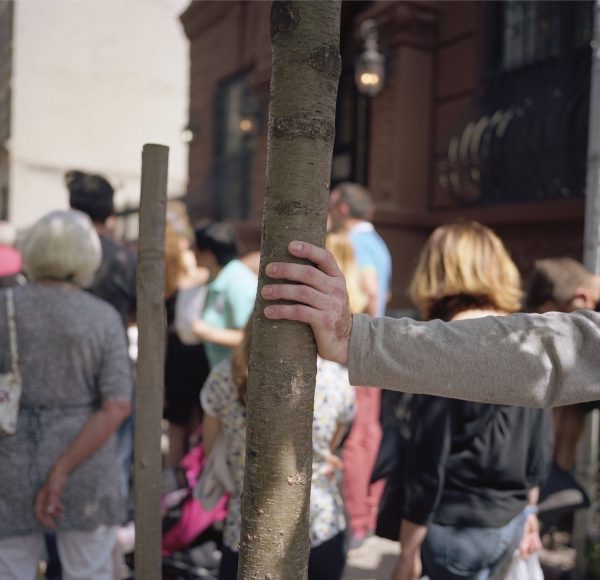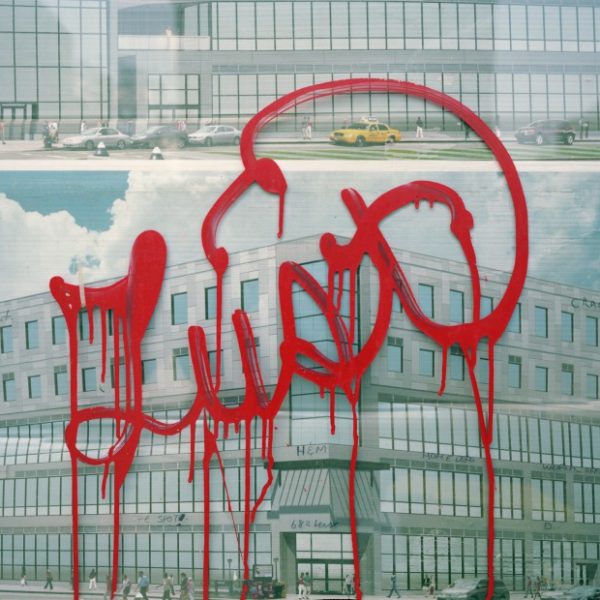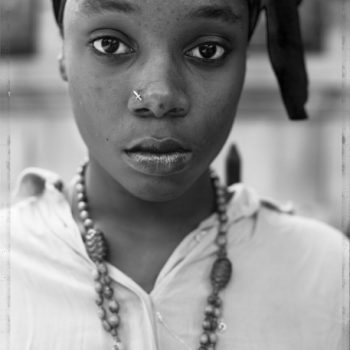_________________________________
This post was predicated upon Dawoud Bey’s American Project at the Whitney Museum of American Art in Oct 2021
_________________________________
Dawoud Bey (b.1953) is an American photographer best known for his large-scale portraits of underrespresented subjects and for his commitment to fostering dialogue about contemporary social and political topics.
Harlem Redux
A writer once wrote that every place is simultaneously the place that it was and the place that it is. It is the combination of the two that constitutes the deeper meaning and experience of a place. And so it is with Harlem.
______________________
It is easy to appreciate the gloriously vibrant and luscious ‘Lust’ as dripping red graffiti: equally, it is possible to view the tag as scrawled out in blood. Contentiously, it is both a mark of disrespect and a badge of honour.
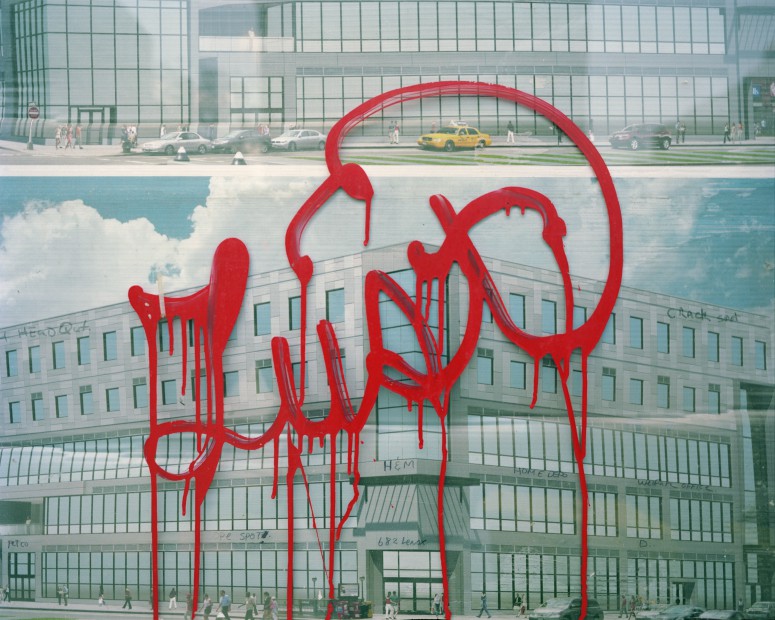
West 124th Street and Lenox Avenue, NY, 2016, Pigmented inkjet print, (printed 2019), 40 3/8” x 48 1/4” x 2” (102.6 x 122.6cm), from Harlem Redux
In this context the word ‘Lust’ is loaded with references and symbolism: a binary in that it champions ‘the street communities’ whilst demeaning corporate America. Still an unequal shoot out between them and us – they bring large scale weapons while we bring pistols.
Meditating on the rationale informing Harlem Redux, Lust could be seen as the instinctual reaction or awakening to the dissection of communal concerns, interests, and sense of belonging that typified Darwoud Bey’s Harlem in the past. The greed of new developers on the scene, cutting the heart out of Harlem’s problematic, yet uniquely heroic history. On the flip side, it is not unreasonable to acknowledge that the same beauty and lusciousness anesthetizes the public into forgetting that driving a wedge through the community is OK. Especially ‘if they can believe’ their lives will be better for it.
Inherently and importantly are obvious binaries: beauty and destruction (equally worthy and worthless); corporate America and local community as two sides of the same coin. Bey comments on the anomalies
I feel that part of the tension, too, is wrapped up in the difference between revitalization and gentrification. Revitalization supposes that the community is being revitalized for the benefit of those already living there; gentrification tends to ultimately displace those living there.
Mega-corporations like Amazon’s Wholefoods and Trader Joe’s (a whopping 530 stores in the US) undoubtedly justify ‘gentrification’ in terms of bringing food and product diversity to the people of Harlem under one roof with all the trimmings.
Though at what cost to local independent store holders – explicitly a century and a half of neighbourhood singularity, history, and familiarity: the heart of Harlem.
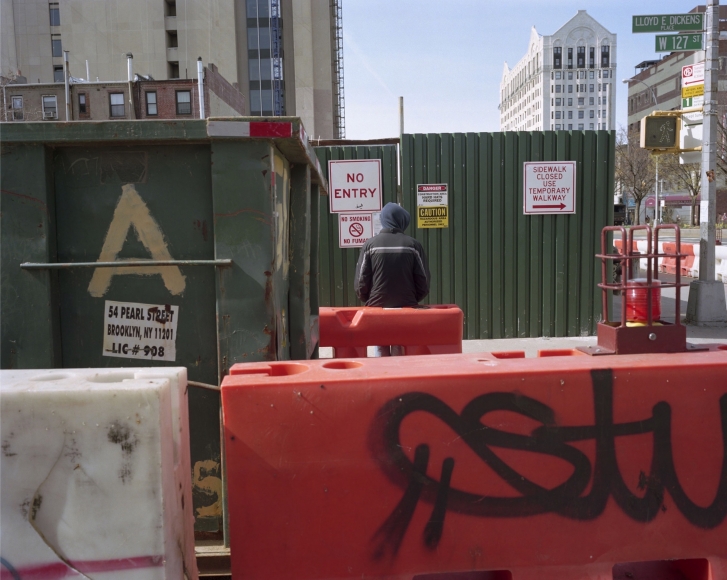
Young Man, West 127th Street, 2015 archival pigment print, 40X48 inches (101.6 x 121.9cms), from Harlem Redux
The rents went up, the whites and tour buses started to come, and black people started to leave, relocating to New Jersey, Connecticut, the Bronx, even “down South,” in search of affordable housing.
Many friends and family left. The shops began to close, and houses that were once $300,000 now easily go for well over $1 million. Studios that were once $500 are now $1,800 if you’re lucky.
Unquestionably the rich unparalleled and irreplaceable history of Harlem is wiped out in a tag of corporate indifference.
Lust against a banal image of corporatization, of ‘one size fits all’; H & M is just visible against a monotonous building in the background; the very antithesis of home-grown conditions and spirit. The sumptuous ‘three-dimensional’ paint against the ‘faded neighbourhood’ photograph, vibrantly projects out to the viewer as if instantly uploaded by a local tagger: understand, current and contemporary view on the street.
This reading in this context speaks to the ‘lust’ for money and profit – typically, the bottom line for developers. Developers are often in the pocket of local politicians. Property magnate Geoffrey Palmer was one of Donald Trump’s biggest donars. Similarly, in 2021 20% of Tory donations in the UK came from Property Developers

Girls, Ornaments, and Vacant Lot, 2016 , archival pigment print, 40X48 inches (101.6 x 121.9cms), from Harlem Redux
Relevantly, the present-day comprises empty lots and buildings ripe for the picking by large corporates in the chain store business. (A timely note: in the last few years H & M have come under fire for contributing to the global waste problem: “H&M is one of the biggest polluters in a pollution-heavy industry: The retailer produces 3 billion garments per year, which amounts to $22 billion in revenue including 4.1 billion of unsold clothes as recently as 2019.“)
The beauty and vitality of the dribbling red paint is a ‘shot in the arm’: a visceral acknowledgement of both the cultural misfit and consequent cultural homogenization by corporate American chain stores on quintessential Harlem.
The sentiment played out in the following significant, soulful quotes by Bey,
DW: And having photographed extensively in Harlem forty years ago, I remember all of those small businesses that are no longer there.
They have been, for the most part, supplanted by upscale restaurants and name-brand retail stores. Sixty Inches from Centre / Everlasting Harlem: A conversation with Dawoud Bey

Dawoud Bey, Mr. Moore’s Bar-B-Que, 125th Street, 1976, 1976, Gelatin silver photograph, 8 × 12 in (20.3 × 30.5cm), Edition 1/10
Typical of the changes that have transformed this community is the McDonald’s where Mr. Moore’s Bar-B-Que luncheonette used to stand on 125th Street and Lenox Avenue.
“I returned to visualize a Harlem in the midst of profound change. Due to increasing gentrification, demographic shifts are permanently altering the social and physical landscape, bringing both new amenities and population displacement, resulting in a radical reshaping of the built environment.”
Harlem is a community that is increasingly defined by a sense of “erase and replace”, wherein pieces of social and cultural history, along with memory itself are routinely being discarded, with only the nostalgic residue of that memory being evoked.
_________________________________
Does politics have a place in art?
How can it not? The whole of our lives is subsumed by the political structure that overlays our society. Political parties and politicians form a key part of society, aka dominant culture, therefore, they exist within the greater world and self-evidently that includes art and art making. Logically, any activity undertaken by corporations, parties or individuals forms part of the prevailing culture (in the west that equates to democracies) whose forces shape the person as one stitch in the complex fabric of life.
Darwoud Bey’s Lust is a simple statement with powerful implications; a stunning paradox at once beautiful and succinct, albeit wide ranging in its symbolism and intertextuality.
_________________________________
_________________________________
Dawoud Bey: An American Project was co-organized by the Whitney Museum of American Art and the San Francisco Museum of Modern Art. The exhibition was co-curated by Elisabeth Sherman, Assistant Curator at the Whitney, and Corey Keller, Curator of Photography at SFMOMA. Bey forms part of REQUIEMS: Reframing History through the Photograph Lens an exhibition at Virginia Museum of Fine Arts
_______________
Darwoud Bey is represented by:
Disclaimer
The work entitled ‘Lust’ was not the leading image in the Whitney Museum of American Art’s exhibition of Dawoud Bey’s ‘American Project’. ‘Lust’ has been chosen here because one, it particularly resonates and two, the word ‘lust’ self evidently contains multiple contextual references: it is especially relevant when considered against some of the themes and concerns reflected in Dawoud Bey’s work – both directly and indirectly. Furthermore, the opinions cited in this article are those of liberal eclectic and have not been sourced from, nor do they necessarily reflect those of Dawoud Bey or the Whitney Museum of American Art. Thus, any mutual or contrary opinion is purely coincidental.


